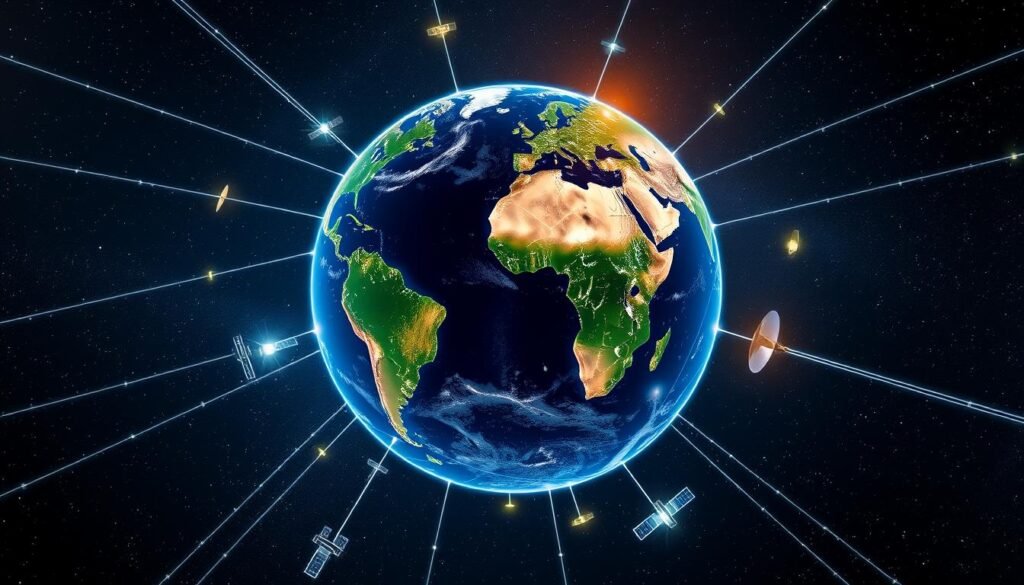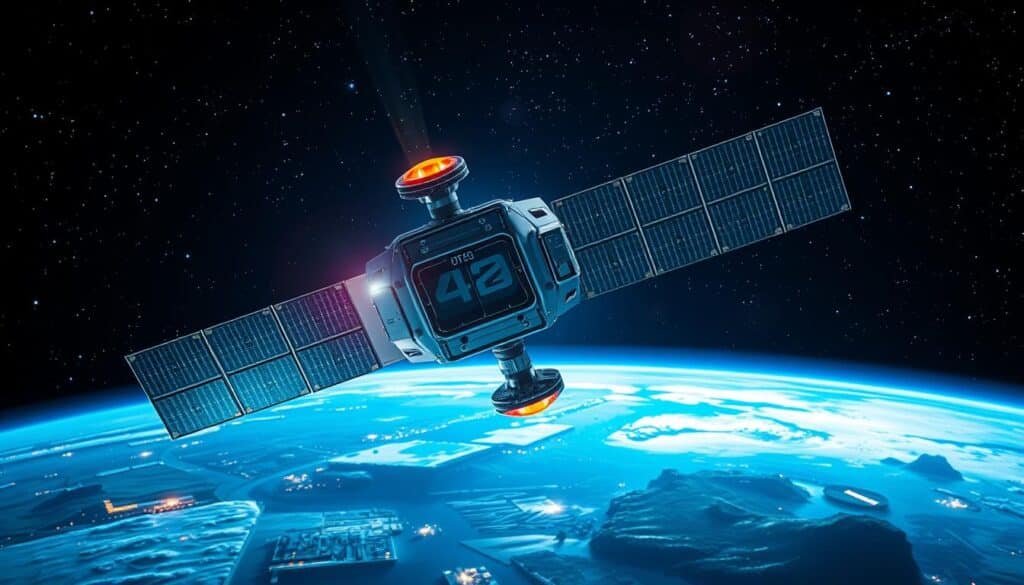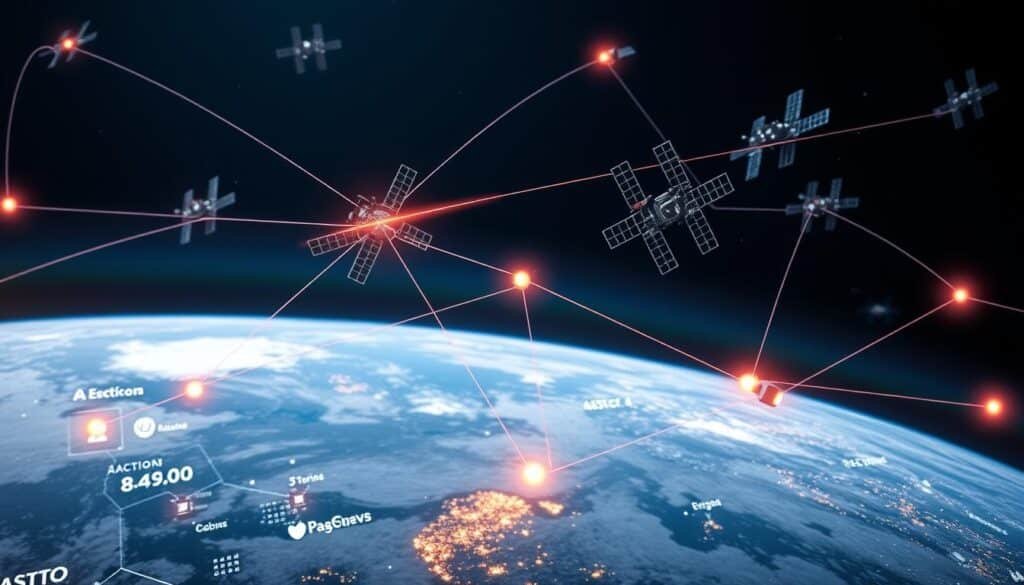Satellite broadcast systems are key to connecting the world. They help bring reliable Internet to places without it. A GSMA report shows 400 million people still can’t get mobile broadband. This highlights the need for satellite services to cover the globe.
Satellites are vital for many areas, like defense, healthcare, and education. The market for satellite communications is growing fast. It’s expected to have 50 million subscribers by 2030.
Key Takeaways : Satellite Broadcast Systems
- Satellite broadcast systems are essential for bridging the digital divide and providing reliable Internet access globally.
- Satellite communications support a wide range of critical applications, including defense, maritime, aviation, healthcare, and education.
- The global satellite communications market is projected to grow substantially, with an estimated 50 million subscribers by 2030.
- Satellite communication providers offer global satellite coverage and satellite Internet services to meet the increasing demand for connectivity.
- Advancements in satellite technology are driving the expansion of satellite broadcast systems for reliable and accessible global communication.
Understanding Modern Satellite Broadcasting Technology
Satellite broadcasting has changed how we get and watch media all over the world. At its core are the satellites, which orbit the Earth in different ways. This gives us reliable, global coverage. Each orbit type has its own benefits, like how fast data can travel and how much area it can cover.
Satellite Orbits and Their Impact on Coverage
LEO satellites are about 300 km up and offer fast data and lots of bandwidth. But, they need many satellites to stay connected. On the other hand, GEO satellites are 36,000 km up. They cover more area with fewer satellites, making them great for TV.
Transmission Bands and Signal Quality
Different frequency bands are used for satellite broadcasts, like C-band, Ku-band, and Ka-band. Each band has its own strengths and weaknesses. C-band signals are strong but need big dishes. Ku-band and Ka-band signals are faster but can be affected by weather.
Network Architecture Components
The process of satellite communication involves many parts. Ground stations send and process content, which is then sent to satellites. The satellites amplify and send it back to Earth. Finally, user terminals, like dishes and receivers, bring the signal to us.
Today’s satellite broadcasting uses a mix of orbits and bands. This mix improves coverage, reliability, and quality. It lets people all over the world enjoy a wide range of high-quality content.
| Satellite Orbit | Altitude | Key Characteristics |
|---|---|---|
| Low Earth Orbit (LEO) | 300 km | Lower latency, higher bandwidth, but requires more satellites |
| Medium Earth Orbit (MEO) | 3,000 – 10,000 km | Balanced performance, fewer satellites needed than LEO |
| Geostationary Orbit (GEO) | 36,000 km | Wider coverage, fewer satellites required, but higher latency |
Leading Satellite Broadcast Systems Providers

In the fast-changing world of satellite broadcasting, top providers are offering global coverage. Viasat, SpaceX Starlink, OneWeb, Eutelsat, and Inmarsat are leading the way. They are shaping the future of this industry.
Viasat provides satellite internet to homes, small businesses, and more worldwide. SpaceX’s Starlink plans to launch 42,000 satellites for fast internet everywhere. OneWeb is backed by big funding to serve governments, businesses, and more with its services.
Eutelsat offers video and IoT services in over 150 countries. Inmarsat focuses on mobile broadband and IoT for maritime, aviation, and government. These companies are leading the satellite communication revolution. They’re investing in LEO satellites to compete with traditional GEO services.
| Provider | Focus Areas | Key Offerings |
|---|---|---|
| Viasat | Residential, Enterprise, Defense | High-speed satellite internet, Connectivity solutions |
| SpaceX Starlink | Global Broadband | Satellite internet network with 42,000 LEO satellites |
| OneWeb | Government, Enterprise | Satellite communication services for various sectors |
| Eutelsat | Video Broadcast, IoT | Satellite video, IoT services in up to 150 countries |
| Inmarsat | Mobile Broadband, IoT | High-speed mobile broadband, IoT solutions |
These top providers are leading the way in global connectivity. They offer innovative solutions for many industries and customers.
Global Coverage and Service Accessibility

Satellite broadcast systems cover different parts of the world, meeting various needs. Starlink currently serves areas above 50 degrees north latitude, aiming to expand further. On the other hand, Eutelsat‘s network reaches over 274 million homes in Europe, the Middle East, and Africa, showing a focus on certain regions.
Coverage Maps and Service Areas
Each satellite system has its own coverage maps and service areas. Some target specific regions or uses, while others aim for global coverage. Knowing these areas is key when choosing a satellite service.
Regional Availability and Restrictions
Availability and restrictions of satellite services vary by region. Some places may not have access to certain providers due to laws, infrastructure, or location. It’s important to check the availability of satellite services in your area for reliable connection.
Connection Speed and Reliability Factors
Satellite systems offer speeds from narrowband (176 Kbps) to high-speed broadband (150-500 Mbps). But, actual speed and reliability depend on weather, satellite position, and network use. It’s important to consider these factors when choosing a service.
“Satellite technology has revolutionized the way we access information and stay connected, offering global solutions that transcend geographical boundaries.”
High-Definition and Ultra HD Broadcasting Capabilities

The satellite broadcast industry is changing fast, focusing on HD and Ultra HD content. By 2026, HD channels via satellite will jump from 23% to 46%. This is because people want better viewing experiences, like the over 75 million 4K TVs sold in 2017.
Satellite tech is great for UHD content, thanks to its bandwidth and wide reach. HD satellite TV and Ultra HD broadcasting through 4K TV satellite systems are changing the game. They make sure 4K content looks amazing everywhere.
Advancing Technology for UHD Broadcast
New tech is making UHD satellite broadcasting more common. The High Efficiency Video Coding (HEVC) standard cuts down bandwidth needs for UHD. This lets broadcasters send 4K content at just 20 Mbps per channel. Also, DVB-S2 protocol lets three to four UHD channels share one 36 MHz C-band transponder.
Big satellite operators like AsiaSat and Eutelsat have launched UHD platforms. They offer many 4K channels. These platforms use the latest tech and satellite systems for a better viewing experience.
“Satellite broadcasting is seen as a perfect distribution platform to meet the bandwidth requirements for UHD content and deliver consistent quality across wide geographic regions.”
The satellite broadcast industry is key for the future of Ultra HD broadcasting and 4K TV satellite tech. As people want better content, satellites will play a big role.
Commercial and Enterprise Satellite Solutions

Satellite technology is changing the game for businesses worldwide. It’s not just for home entertainment anymore. It’s powering commercial and enterprise solutions across many industries. From ships at sea to planes in the sky, it’s changing how we work globally.
Maritime and Aviation Applications
The maritime and aviation worlds have seen huge benefits from satellite tech. Maritime satellite communications offer voice, data, and video services for ships. Aviation connectivity keeps planes connected with the ground, ensuring safety and comfort for all on board.
Corporate Network Solutions
Enterprise satellite networks give businesses a fast and secure way to communicate. They support high-speed data and video calls, and even create private networks. This tech is changing how companies work across the globe.
Emergency Response Systems
In emergencies, satellite tech is a vital lifeline. It provides fast, reliable connections in disaster zones. This helps rescue teams work together effectively.
Companies like Inmarsat are leading the way with their ELERA and Global Xpress services. They offer tailored satellite solutions for businesses. This tech boosts global connectivity, productivity, and resilience for companies everywhere.
Residential and Consumer Broadcasting Services
Satellite broadcasting has grown a lot for homes. Direct-to-home (DTH) satellite TV, offered by Eutelsat, has changed how we get entertainment and news. Eutelsat now reaches over 274 million homes. They offer 6,500 TV channels, 2,200 HDTV channels, and 1,100 radio stations.
Consumer satellite internet, like Starlink, has also changed how we connect. Starlink provides fast internet, with speeds of 104.97 Mbps in the US. These services are great for both fixed and mobile use, like in RVs.
These services meet many needs, from fun to fast internet. Prices and options vary by area and provider. Yet, they make home entertainment and communication easier and more accessible.
Also Read : The Evolution Of Cable Tv: From Analog To Digital
FAQs
Q: What is a satellite TV system?
A: A satellite TV system is a technology used to receive television signals transmitted via communication satellites. It typically includes a satellite dish antenna, a satellite receiver, and a decoder to convert the broadcast signals into viewable content on television.
Q: How does satellite television transmission work?
A: Satellite television transmission works by using a direct broadcast satellite (DBS) to transmit and receive television signals. The satellite uplinks the signals from a broadcast center to the satellite, which then downlinks the signals to satellite dishes installed at viewers’ homes.
Q: What equipment is needed for satellite TV reception?
A: To receive satellite television, you need a satellite dish antenna, a satellite receiver, and a decoder. The satellite dish collects signals from the satellite, and the receiver decodes these signals for viewing on your television.
Q: What are the advantages of using a satellite TV system?
A: The advantages of a satellite TV system include a wide range of television channels, reliable global coverage, and the ability to receive digital broadcasting, which offers better picture and sound quality compared to analog systems.
Q: Can I receive satellite radio through a satellite TV system?
A: Yes, some satellite TV systems offer the option to receive satellite radio. This provides listeners with a variety of music, news, and talk radio programming transmitted through the same satellite technology.
Q: What is the frequency range used in satellite broadcasting?
A: Satellite broadcasting typically operates in the GHz frequency range, which allows for the transmission of high-quality digital television signals and ensures effective communication between the satellite and ground stations.
Q: What role do earth stations play in satellite broadcasting?
A: Earth stations serve as the ground-based facilities that transmit and receive signals to and from the satellite. They play a critical role in the operation of satellite television systems by ensuring that broadcast signals are effectively sent to satellites in geosynchronous orbit.
Q: What is the difference between direct broadcasting and traditional broadcasting?
A: Direct broadcasting involves transmitting television signals directly from a satellite to a viewer’s home satellite dish, allowing for a more extensive selection of channels and improved reception. Traditional broadcasting typically relies on terrestrial towers, which can limit coverage and channel availability.
Q: What is the significance of digital satellite broadcasting?
A: Digital satellite broadcasting provides higher quality television signals compared to analog broadcasting. It allows for better picture resolution, sound quality, and can accommodate more channels within the same bandwidth, making it a preferred choice for modern viewers.
Q: How did early satellite television systems operate?
A: Early satellite television systems utilized analog signals and were limited in channel selection and reception quality. With advancements in technology, digital satellite systems have replaced these older systems, improving overall viewer experience with enhanced programming options and signal clarity.
Source Links
- https://www.eutelsat.com/en/satellite-communication-services/broadcasting-solutions.html
- https://www.ses.com/find-service/broadcasters
- https://www.intelliantech.com/en/products/directv-and-global-satellite-tv/
- https://www.intelsat.com/resources/tools/satellite-101/
- https://en.wikipedia.org/wiki/Satellite_television
- https://www.abiresearch.com/blogs/2022/12/12/satellite-communication-service-providers/
- https://www.imarcgroup.com/satellite-communication-companies
- https://www.globalstar.com/
- https://novatel.com/tech-talk/an-introduction-to-gnss/what-are-global-navigation-satellite-systems-gnss
- https://www.nasa.gov/smallsat-institute/sst-soa/soa-communications/
- https://www.gminsights.com/industry-analysis/4k-satellite-broadcasting-market
- http://www.satmagazine.com/story.php?number=2041763180
- https://www.eutelsat.com/en/satellite-communication-services/broadcasting-solutions/hd-uhd-4k-broadcast.html
- https://www.gsa.gov/technology/it-contract-vehicles-and-purchasing-programs/telecommunications-and-network-services/satellite-communications-products-and-services
- https://www.ses.com/
- https://sia.org/satellites-services/broadcast-satellite-tv-radio/
- https://www.idirect.net/media-and-broadcast/


